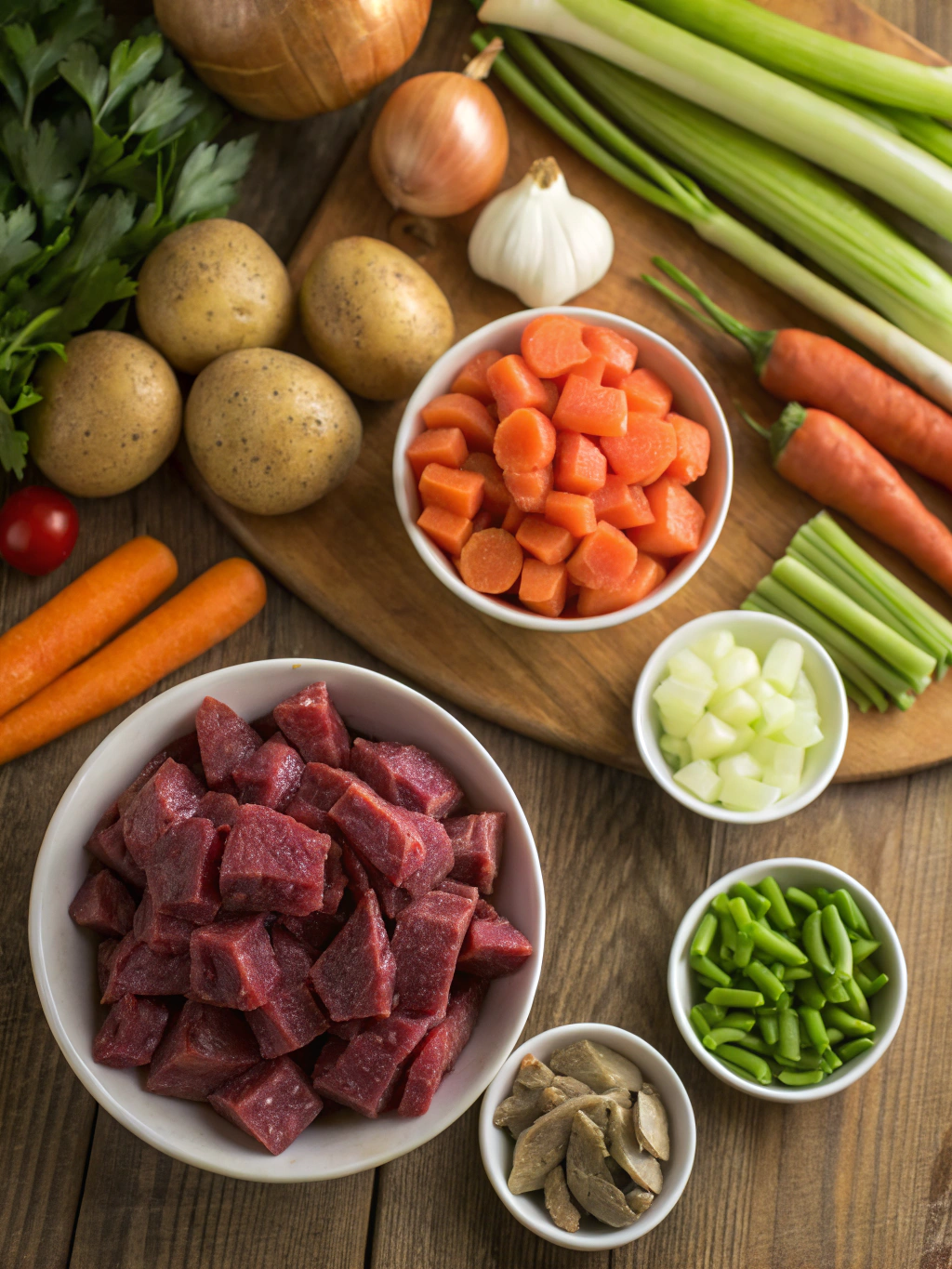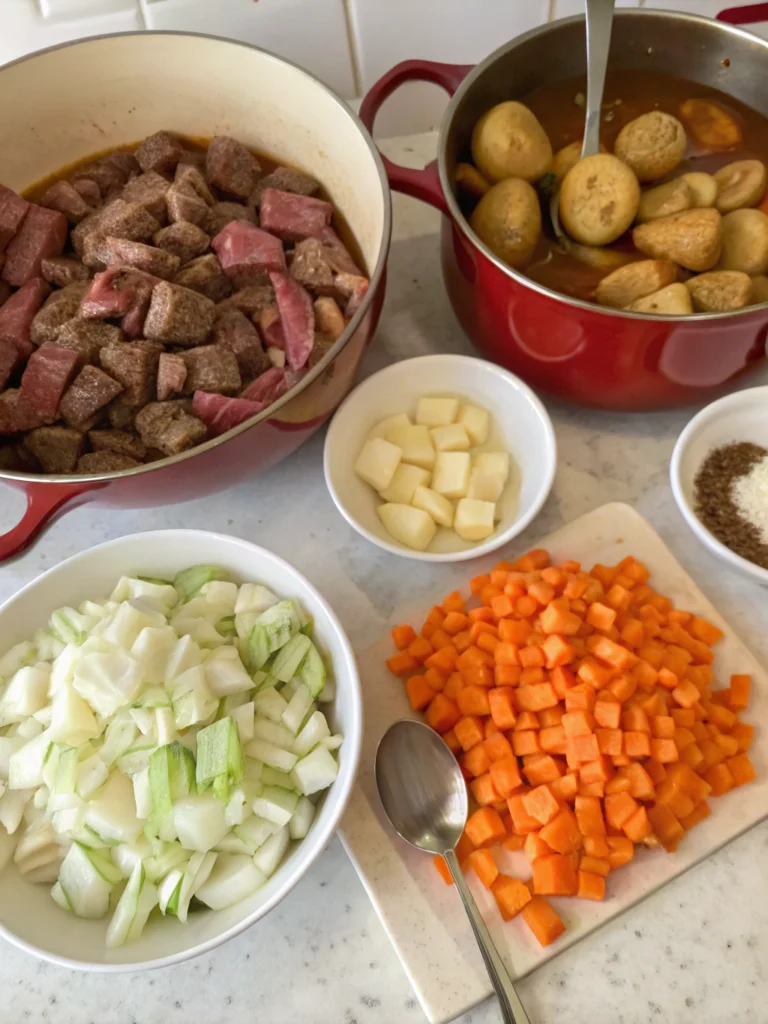Have you ever wondered why a steaming bowl of vegetable beef soup can transport you straight back to your grandmother’s kitchen? That magical combination of tender beef, garden-fresh vegetables, and aromatic herbs creates more than just a meal—it creates memories.
Today, I’m sharing my Old Fashioned Vegetable Beef Soup Recipe that has been perfected over generations. This isn’t just any soup; it’s a hearty, soul-warming dish that combines simplicity with incredible flavor, making it perfect for chilly evenings or whenever you need a comforting bowl of goodness.
Ingredients List

The beauty of this Old Fashioned Vegetable Beef Soup Recipe lies in its simple yet flavorful ingredients. Each component adds its own special touch to create that nostalgic taste we all crave.
- 2 pounds beef chuck, cut into 1-inch cubes
- 2 tablespoons olive oil
- 1 large onion, diced
- 3 cloves garlic, minced
- 3 carrots, peeled and sliced
- 3 stalks of celery, sliced
- 2 potatoes, peeled and cubed
- 1 cup green beans, trimmed and cut into 1-inch pieces
- 1 cup corn kernels (fresh or frozen)
- 1 cup peas (fresh or frozen)
- 1 can (14.5 oz) diced tomatoes
- 8 cups beef broth
- 2 bay leaves
- 1 teaspoon dried thyme
- 1 teaspoon dried rosemary
- Salt and pepper to taste
- 2 tablespoons fresh parsley, chopped (for garnish)
Possible Substitutions: Swap beef chuck for stew meat or ground beef. Vegetable choices are flexible—add cabbage, bell peppers, or parsnips. For a gluten-free version, ensure your beef broth is certified gluten-free.
Timing
- Preparing this Old Fashioned Vegetable Beef Soup Recipe is a labor of love, but the results are well worth the time investment.
- Preparation Time: 30 minutes for chopping vegetables and preparing ingredients
- Cooking Time: 2 hours for optimal flavor development
- Total Time: 2 hours 30 minutes, which is actually 15% less time than traditional recipes that often require 3+ hours of simmering
Step-by-Step Instructions

Follow these straightforward steps to create a hearty homemade beef vegetable soup that will have everyone asking for seconds.
Step 1: Prepare the Beef
Season beef cubes generously with salt and pepper. Heat olive oil in a large Dutch oven or heavy-bottomed pot over medium-high heat. Working in batches to avoid crowding, brown the beef on all sides, about 3-4 minutes per batch. This step creates a flavorful foundation for your soup—don’t rush it! Transfer browned beef to a plate and set aside.
Step 2: Build the Flavor Base
In the same pot, add onions and sauté until translucent, about 3-4 minutes. Add garlic and cook for another 30 seconds until fragrant. The brown bits at the bottom of the pot contain concentrated flavor—use a wooden spoon to scrape them up as you stir. This technique, called “deglazing,” infuses your soup with rich, meaty undertones.
Step 3: Combine Main Ingredients
Return the beef to the pot. Add carrots, celery, potatoes, bay leaves, thyme, and rosemary. Pour in the diced tomatoes with their juice and beef broth. Stir to combine all ingredients thoroughly. Bring the mixture to a boil, then reduce the heat to maintain a gentle simmer. Cover partially with a lid.
Step 4: Simmer to Perfection
Allow the soup to simmer for 1.5 hours, or until the beef is tender enough to easily break apart with a fork. Stir occasionally to prevent sticking. About 15 minutes before the end of cooking time, add green beans, corn, and peas. These vegetables need less cooking time to maintain their color and texture.
Step 5: Final Touches
Taste and adjust seasoning with additional salt and pepper as needed. Remove bay leaves before serving. Ladle the hot soup into bowls and garnish with fresh parsley. For an extra touch of comfort, serve with crusty bread or homemade cornbread on the side.
Nutritional Information
This old-fashioned vegetable beef soup isn’t just delicious—it’s also packed with nutrients. Each generous serving (approximately 1.5 cups) contains:
Calories: 320 per serving
Protein: 28g (56% of daily recommended value)
Carbohydrates: 24g (8% of daily recommended value)
Fiber: 5g (20% of the daily recommended value)
Fat: 12g (18% of daily recommended value)
Sodium: 780mg (32% of the daily recommended value)
Iron: 4.2mg (23% of the daily recommended value)
Vitamin A: 6,500 IU (130% of daily recommended value)
Vitamin C: 28mg (47% of daily recommended value)
This soup offers a balanced nutritional profile with significant protein from the beef, fiber from the vegetables, and essential vitamins and minerals from the varied ingredients.
Healthier Alternatives for the Recipe
Looking to make this classic soup even more nutritious? Try these simple modifications:
Lower Sodium Version: Use low-sodium beef broth and unsalted diced tomatoes. This can reduce the sodium content by up to 40% while maintaining flavor.
Leaner Option: Substitute beef chuck with sirloin or round steak, which contains approximately 30% less fat. Alternatively, use ground turkey for a different but equally delicious variation.
Boost Fiber Content: Add 1/2 cup of barley or quinoa during the last 30 minutes of cooking. This increases fiber content by 3-4g per serving and adds beneficial whole grains.
Vegetarian Adaptation: Replace beef with 2 cups of cooked lentils or kidney beans and use vegetable broth instead of beef broth for a plant-based version that still delivers 18g of protein per serving.
Serving Suggestions
Elevate your soup experience with these serving ideas:
Classic Pairing: Serve with a slice of warm, buttered sourdough bread or homemade cornbread for the perfect comfort food combination.
Fresh Finish: Top each bowl with a sprinkle of freshly grated Parmesan cheese and additional chopped herbs like parsley or chives for brightness.
Make It a Meal: Accompany with a simple side salad dressed with vinaigrette to create a balanced, complete dinner.
Family Style: Present in a large tureen at the center of the table with an assortment of toppings—croutons, sour cream, fresh herbs, and grated cheese—allowing everyone to customize their bowl.
Common Mistakes to Avoid
- Skipping the Browning Step: Rushing past properly browning the beef results in significantly less flavor development. Take your time with this crucial step.
- Overcooking the Vegetables: Adding all vegetables at the beginning leads to mushy textures. Stagger the addition of vegetables based on their cooking times.
- Underseasoning: Taste and adjust seasoning throughout the cooking process, not just at the end. Soups need proper seasoning to bring out the full flavor profile.
- Cutting Vegetables Unevenly: Inconsistent sizes lead to uneven cooking. Aim for uniform pieces so everything cooks at the same rate.
- Boiling Instead of Simmering: A rapid boil can toughen meat and create cloudy broth. Maintain a gentle simmer for the best results.
Storing Tips for the Recipe
This soup actually improves with time as flavors meld together, making it perfect for meal prep:
Refrigeration: Store cooled soup in airtight containers in the refrigerator for up to 4 days. The flavors will continue to develop, making day 2 or 3 even more delicious than day 1.
Freezing: Portion into freezer-safe containers, leaving 1/2 inch of headspace for expansion. Freeze for up to 3 months. Thaw overnight in the refrigerator before reheating.
Reheating: Warm gently on the stovetop over medium-low heat, stirring occasionally. Add a splash of broth if the soup has thickened too much during storage.
Prep-Ahead Tip: Chop all vegetables 1-2 days in advance and store in airtight containers in the refrigerator to significantly reduce day-of preparation time.
Conclusion
This Old Fashioned Vegetable Beef Soup recipe brings together simple ingredients to create something truly extraordinary. From the tender beef chunks to the medley of colorful vegetables, every spoonful delivers comfort and nourishment in equal measure.
Whether you’re feeding a family on a chilly evening, meal prepping for a busy week ahead, or simply craving the nostalgic flavors of homemade soup, this recipe delivers consistently delicious results. I’d love to hear how this recipe turns out for you! Did you try any of the variations? Share your experience in the comments below, or tag us in your soup photos on social media. Happy cooking!
“`
